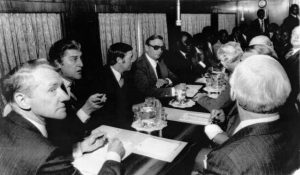Agents of Apartheid John Vorster and Ian Smith
Unlike the trend observed in the rest of Africa during Zimbabwe’s liberation struggle, the white minority regime in South Africa struggled to frustrate the ambitions of black nationalists in Rhodesia. South Africa’s support for Ian Smith’s unilateral government was founded on the principle of apartheid which characterized both regimes. From 1966 until his retirement in 1978, South African Prime Minister John Vorster struggled to build another racist regime in Rhodesia.
The Vorster-Smith Coalition: An Anti-black Alliance
As African nationalists intensified their guerrilla campaigns against the white minority and illegal government of Smith, Vorster also increased his support for Smith’s unpopular regime. Vorster and Smith cemented their friendship in a military and economic alliance which was meant to promote white minority rule in both countries. This gave Vorster the excuse to use military force to protect his ally.
The involvement and activities of African National Congress (ANC) guerrillas in Rhodesia gave Vorster the much needed pretext to dispatch South African police continents to assist Smith in what he called “border control.” According to historians Hasu H. Patel and H.H.K Bhila, South Africa also sent some army regulars to man fast patrol boats on the Zambezi river and supplied helicopters and pilots to Smith.
Economic Diplomacy, Vorsters Weapon against Black Nationalists in Rhodesia
To frustrate the ambitions of black Rhodesians, Vorster adopted an economic diplomacy which political activist Richard Hall describes as being “assertive” and “outward looking.” The purpose of this policy was to intensify links with friendly governments and to seek new friends in Africa. This was aimed at cracking African solidarity for the Rhodesian course.
The economic dimension of South Africa’s assertive foreign policy was its “aid diplomacy” which was aimed at wooing African countries towards South Africa. By 1971, Lesotho, Malawi, Madagascar and Mauritius had accepted South African aid. Alongside the Ivory Coast, Gabon and Ghana (under Dr. Bushia), they advocated a policy of “dialogue” within the OAU. By “dialogue,” they meant the abandonment of the OAU’s harsh stance towards South Africa and its rebel ally – Smith.
South Africa’s divisive diplomacy almost paid off when a large crack emerged within the OAU between supporters of “dialogue” and those opposed to it. According to South African academic Sam Nolutshungu, this crack gave South Africa the opportunity “… to look forward to a period of less meaningful opposition to minority rule in Southern Africa, and could hope to use its considerable economic and military power to consolidate and build upon its gains.”
The Demise of Apartheid and Triumph of African Nationalism in Rhodesia; Vorster’s Failure in Zimbabwe
Though Vorster joined the U.S., Portugal, France and Japan in flouting all UN sanctions against Smith’s regime, many forces acted against South Africa’s agenda for white-ruled Rhodesia. Firstly, a coup in Portugal in 1974 led to the independence of Angola and Mozambique. The new regime in Lisbon was less cooperative with Pretoria. This constituted a significant loss of a vital ally in the game of apartheid.
Secondly, as the situation in Rhodesia degenerated into a cold war show down, the U.S. increasingly sought a peaceful solution to the crisis. This meant that Vorster had to rethink his strategies especially as Washington mounted pressure on Pretoria to abandon the path of force. America’s choice of peace was influenced by the growing support for Rhodesian guerrillas from communist countries especially Russia, China and Cuba.
John Vorster resigned as South African Prime minister in 1978 after twelve years in office. His entire tenure coincided with the period of Zimbabwe’s liberation struggle – the Chimurenga. One year after the resignation of Vorster, the path to peace in Zimbabwe became very clear as all stake holders in the conflict met in Lusaka and Lancaster (1979) to witness the birth of a new Zimbabwe a year later.





